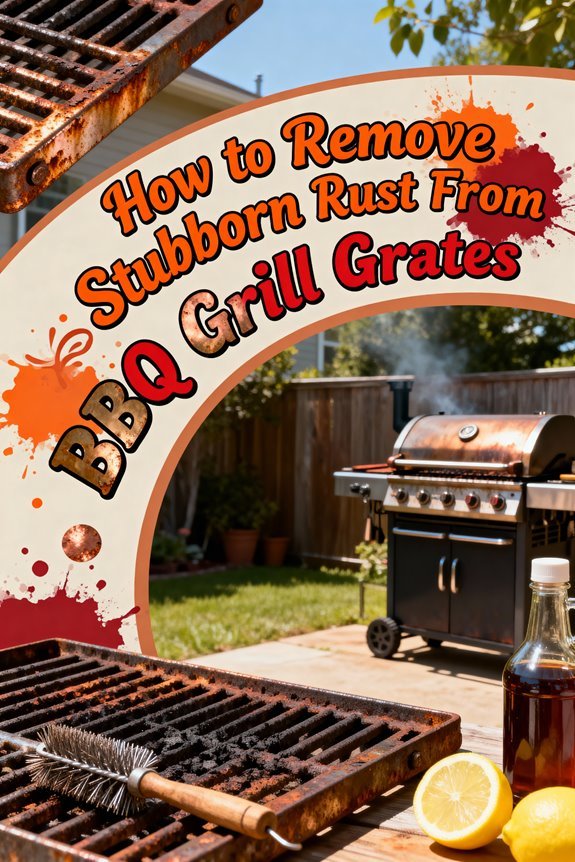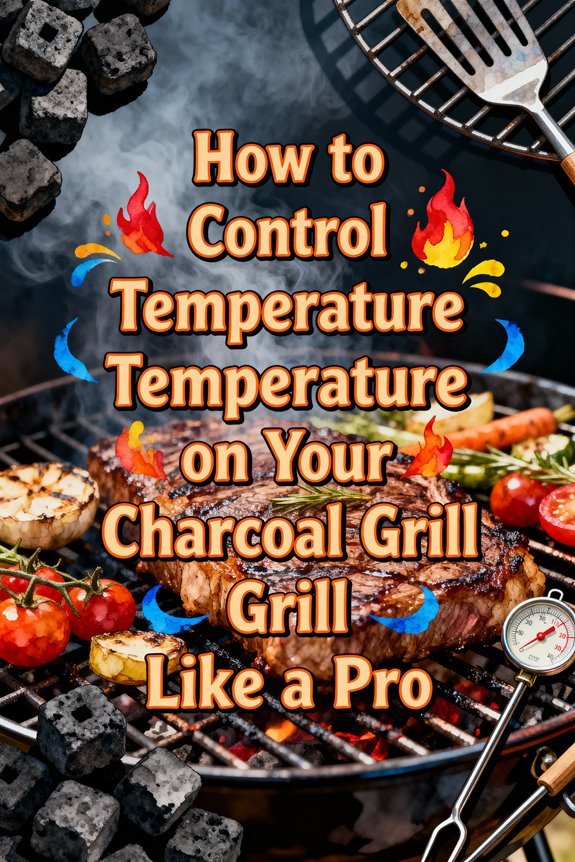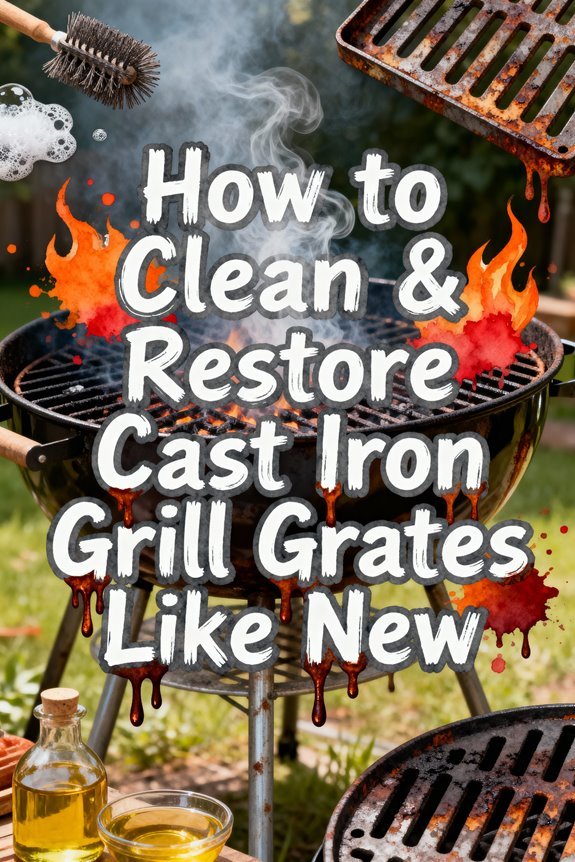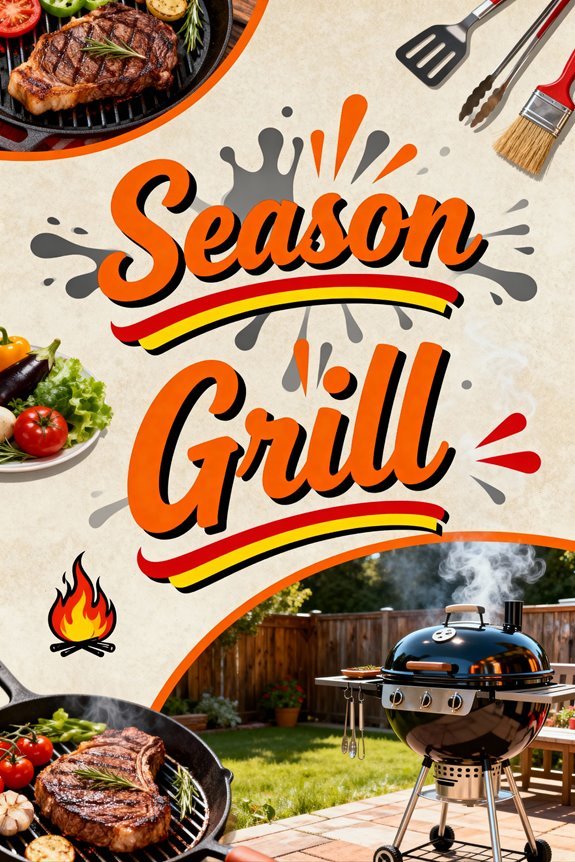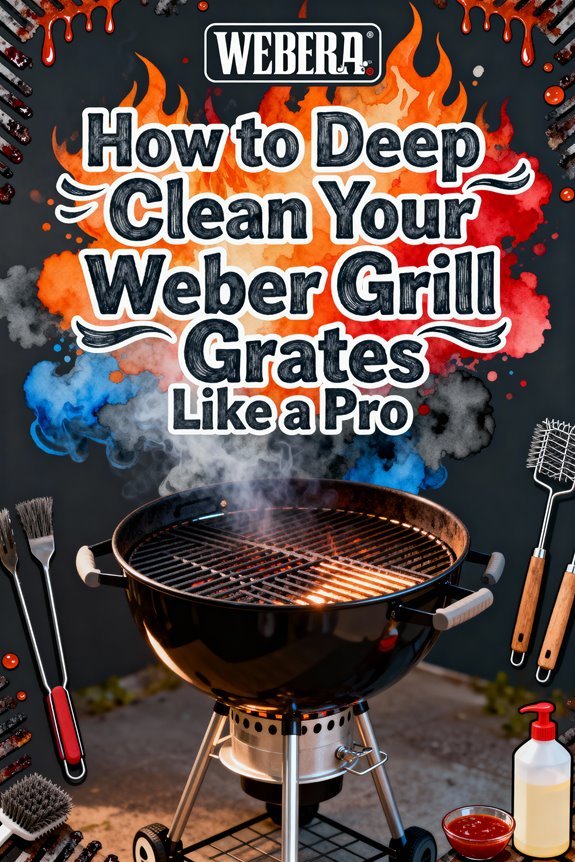To remove stubborn rust from BBQ grill grates, preheat your grill to 350-400°F to oxidize and loosen rust particles. Use a stainless steel brush for mechanical abrasion, then apply a vinegar-baking soda paste to dissolve remaining corrosion. For deep-seated rust, scrub with 80-120 grit sandpaper. After removing all oxidation, rinse thoroughly with warm water and dry completely. Apply a thin coat of high-smoke-point oil like canola or grapeseed, then heat at 350-400°F for 40-60 minutes to create a protective polymerized barrier. Understanding proper maintenance techniques guarantees your grates stay rust-free long-term.
Understanding Why Rust Forms on Your Grill Grates
When iron-based metal in your grill grates encounters oxygen and moisture simultaneously, it undergoes oxidation—a chemical reaction that produces iron oxide, commonly known as rust. This process initiates at microscopic cracks, scratches, or damaged protective coatings, then accelerates in humid environments exceeding 60% relative humidity. Coastal regions present heightened risk due to salt-laden air catalyzing oxidation processes. Temperature fluctuations cause overnight condensation, continuously exposing metal surfaces to moisture. Cast iron and mild steel grates corrode faster than stainless steel, though all rust types can develop when protective barriers fail. Water pooling from inadequate drainage, combined with compromised ceramic or powder coatings, creates conditions for rapid rust spread. Leaving grates outdoors between grilling sessions dramatically increases exposure to moisture and accelerates the oxidation cycle. Regular maintenance using a heat-resistant sponge brush at 400°F helps prevent rust formation by removing residue that can trap moisture. White vinegar solutions can help dissolve existing rust and prevent further oxidation when used regularly. Understanding these oxidation processes enables you to implement targeted prevention strategies before structural degradation occurs.
Essential Tools and Materials for Rust Removal
Now that you understand the chemical processes causing rust formation on your grill grates, you’ll need specific tools and materials to safely and effectively remove existing corrosion. Essential equipment includes stainless steel brushes for initial scrubbing, 80-120 grit sandpaper for deep-seated rust, and metal scrapers for dislodging debris from grooves. For cleaning solutions, use vinegar-baking soda paste to dissolve oxidation, followed by mild dish soap for degreasing. After rust removal, apply a thin coat of vegetable oil for rust prevention. Invest in safety gear—gloves and eye protection—to prevent injury during scrubbing. Maintain cleaning frequency of every 3-4 uses, and store grates under a weatherproof cover. For heavily corroded surfaces, drill-powered spin brushes considerably reduce labor time while ensuring thorough rust elimination. A heavy-duty Scotch-Brite pad combined with warm soapy water effectively removes surface rust from exterior grill components. For optimal results, soak grill grates in soapy water before scrubbing to help loosen stubborn rust and grime. Using aluminum foil balls can provide an effective alternative scrubbing method when brushes aren’t available.
Preparing Your Grill Grates With Heat
Before applying any mechanical cleaning methods, heat treatment serves as a critical preparatory step that greatly reduces the physical effort required for rust removal. Preheat your grill to approximately 350°F by igniting charcoal or activating burners for 10 to 20 minutes. Close the hood and adjust dampers to maintain steady temperature. This controlled heat treatment accelerates rust oxidation, causing surface particles to flake and separate from the metal substrate. Baking soda paste applied before heating helps break down stubborn deposits naturally. Monitor temperature using a built-in thermometer or digital probe to prevent component damage from overheating. Position your grill in a well-ventilated outdoor area, removing combustible materials from the vicinity. Use heat-resistant gloves and long-handled tools when handling hot grates. Regular maintenance steps help prevent rust from forming in the first place. After the 20-minute heating cycle, you’ll notice loosened rust deposits ready for efficient removal with bristle-free brushes or natural abrasives. For an eco-friendly alternative, use an onion half to scrub the grates while they’re still warm, which adds natural flavor while removing stubborn rust.
Manual Scrubbing Techniques for Heavy Rust Buildup
After heat treatment loosens surface oxidation, you’ll need to employ mechanical abrasion to eliminate heavy rust deposits that remain bonded to the grate material. Begin by scraping large rust chunks with a putty knife, then soak grates in 50/50 vinegar-water solution for 30 minutes minimum to dissolve remaining corrosion. Apply baking soda paste (3:1 ratio) directly to rust spots and scrub using nylon brushes for stainless steel or wire brushes for cast iron. For porcelain-coated surfaces, exclusively use heavy-duty synthetic pads to prevent enamel damage. Advanced scrubbing techniques include salt-vinegar combinations for increased rust removal efficiency and fine-grit sandpaper wrapped around bars for stubborn deposits. Always wear gloves in well-ventilated areas, dry grates thoroughly post-cleaning, and season cast iron immediately with vegetable oil to prevent re-rusting. Ensure all cleaning agents are rinsed off completely to prevent chemical residue from contaminating food contact surfaces. For optimal results, consider using 220-grit sandpaper on particularly resistant rust spots before proceeding with chemical treatments. Regular drip pan maintenance helps prevent moisture accumulation that can lead to future rust formation.
Using Chemical Cleaners on Stainless Steel Grates
Chemical cleaners offer targeted solutions for rust removal on stainless steel grates when you’ve exhausted manual scrubbing methods or need gentler surface treatment. Select products specifically labeled safe for food-contact surfaces to guarantee chemical safety and prevent toxic residue contamination. White vinegar and baking soda paste demonstrate excellent cleaner effectiveness—apply for 30 minutes to overnight depending on rust severity. For heavy buildup, heat grates first to enhance chemical penetration, then spray diluted vinegar evenly across surfaces. Avoid bleach, phosphoric acid, or steel wool that damage stainless steel’s protective layer. After treatment, rinse thoroughly with warm water and dry completely before cooking. Post-cleaning, season grates with oil to establish a protective barrier. Lemon juice can be added to cleaning mixtures to boost cleaning power when tackling particularly stubborn rust stains. Drip pans removal helps prevent grease buildup and future rust formation during regular maintenance. Regular grate brushing before and after each use helps prevent carbonized grease accumulation that leads to rust. Wear gloves and maintain adequate ventilation when handling any chemical cleaners to minimize exposure risks.
Restoring Shine With Polish and Protective Coatings
Three distinct methods restore your grill grates’ original luster after rust removal: mechanical polishing, natural agent application, and protective coating layering. For polishing techniques, use fine steel wool or brass brushes on cast iron, avoiding wire brushes on stainless steel to prevent surface scratches. Apply metal-specific polish, then buff with soft cloth using circular motions. Natural alternatives include lemon juice-vegetable oil mixtures or baking soda paste for food-safe polishing. Using a non-abrasive cloth helps maintain the stainless steel’s protective chromium oxide layer. High temperature cleaning at 500-550°F helps loosen stubborn grime before polishing.
After polishing, apply protective products immediately. Coat cooled grates with high smoke point oils (canola, grapeseed) at 400°F+ tolerance. For cast iron, season by heating oil-coated grates to create polymerized rust barriers. Commercial food-safe rust inhibitors and grill-specific waxes offer extended protection but require reapplication based on usage frequency. Ensure grates are dried thoroughly after cleaning to prevent new rust formation. Store grates in dry, covered environments between uses.
Applying Oil to Create a Rust-Resistant Barrier
Once you’ve restored your grill grates’ protective shine, you’ll need to establish a long-term rust-prevention strategy through proper oil application. Select high-smoke-point oils like vegetable, canola, or grapeseed oil—avoid butter or margarine, which burn at lower temperatures. Palm oil is another excellent option for creating a protective barrier against rust. After thoroughly cleaning and drying your grates, apply a thin, even layer using a brush or cloth. Paper towels work well for applying an even coating without excess oil buildup. Heat the oiled grates at 350–400°F (175–205°C) for 40–60 minutes to polymerize the oil, creating a durable barrier that repels moisture and prevents oxidation. This temperature range is ideal since it’s similar to medium-high heat used for grilling foil-wrapped potatoes. Reapply oil after each grilling session while grates remain warm. This consistent oil application maintains seasoning, provides rust prevention, and creates a non-stick surface. Store oiled grates in dry environments to maximize protection during extended inactivity periods.
Best Practices for Post-Cooking Grate Maintenance
Proper grill grate maintenance immediately after cooking extends equipment lifespan and prevents costly rust damage. Initiate post cooking cleaning while grates remain hot, using a stainless steel or bristle-free brush to remove food residue before it hardens. If you’ve missed immediate cleaning, preheat your grill to 500°F+ for 10–15 minutes to loosen debris effectively. Deep cleaning solutions made from vinegar and baking soda can help remove tough buildup during seasonal maintenance. This approach reduces effort and maintains ideal heat transfer.
After scrubbing, rinse grates thoroughly with clean water and dry completely using a cloth or air-dry in ventilated spaces to prevent moisture accumulation. When grilling chicken, ensure safe temperature control by cleaning grates immediately after use to prevent bacterial growth and cross-contamination. Conduct routine inspections for early rust formation, buildup, or structural damage. Address small rust spots immediately with gentle scrubbing before deterioration spreads. For particularly stubborn stains, place the shiny side of tinfoil over problem areas while heating the grill to create concentrated convection that breaks down baked-on residue. Maintain cleaning records to track frequency and grate condition, enabling timely corrective measures that preserve your grill’s integrity.
Protecting Your Grill From Environmental Damage
While indoor storage provides ideal protection, environmental factors like humidity, temperature fluctuations, and precipitation actively accelerate grill deterioration when equipment remains exposed outdoors. You’ll achieve optimal rust prevention by maintaining relative humidity below 50% in storage areas and applying a food-safe protective coating with a minimum thickness of 0.001 inches after each use. Just as olive oil protects metal surfaces, it can also be used as a natural rust-prevention coating. Cover your grill with UV-resistant, waterproof materials rated for outdoor exposure to shield components from moisture infiltration and corrosive pollutants. Consider the environmental impact of your protective products—select biodegradable oils and non-toxic sealants that won’t contaminate soil or groundwater. Position grills on moisture-resistant pads elevated 2-3 inches above ground level, ensuring adequate air circulation underneath. Maintain a clean grill to ensure efficiency and prevent rust buildup that compromises both performance and longevity. Regular cleaning with aluminum foil scrubbing provides a safe and effective way to remove buildup without damaging grate surfaces. These measures considerably extend equipment lifespan while minimizing replacement frequency and associated environmental waste.
Special Considerations for Coastal and Humid Climates
Because salt-laden air contains chloride ions measuring 0.1-1.0 mg/m³ within 300 meters of coastlines, you’ll face accelerated corrosion rates 400-600% higher than inland locations. Coastal humidity demands weekly maintenance protocols using oxalic acid-based stainless steel cleaners—never chlorine products, which accelerate oxidation. After each cleaning session, you must guarantee complete drying before storage to prevent moisture accumulation beneath protective covers. Salt Lake City-based Traeger recommends specific anti-corrosion treatments for their grills used in coastal environments.
Use covers only during precipitation events; continuous covering in humid environments traps condensation and accelerates rust formation. Maintain air circulation around your grill’s exterior surfaces, and inspect stainless steel components biweekly for early-stage oxidation. For stubborn rust deposits, apply salt-vinegar soaking solutions or employ electrolysis methods on severely affected areas. Regular seasoning of cast iron grates creates essential protective barriers against coastal humidity’s persistent corrosive effects on grill care. High-end models can withstand coastal conditions for up to 20 years with proper maintenance. Apply vegetable oil coatings after each cleaning to establish a moisture-resistant barrier that prevents rust formation in high-humidity environments.
[affiai keyword=”coastal grill rust prevention products” template=”carousel” count=”3″

